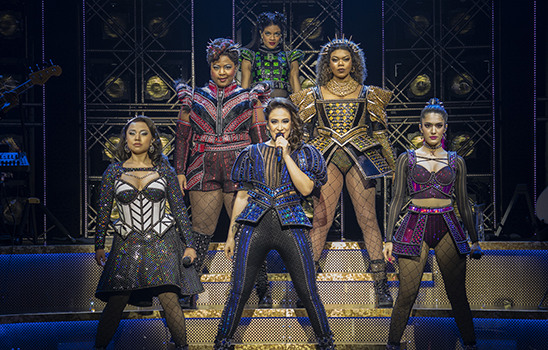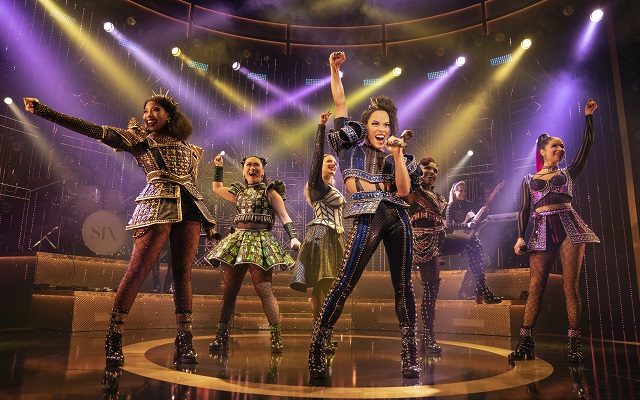
If you’ve spent any time listening to Top Forty radio or watching television talent shows like ”American Idol” and “The Voice” over the past decade or two, the nine songs featured in “Six” will feel remarkably familiar.
Not that this fan-magnet musical about the wives of Henry VIII, now at the Orpheum Theater on its first national tour, is a work of hitlist stitchery like its current Broadway peers “Moulin Rouge” and “& Juliet”
Nor does “Six” belong to either of the two earlier strains of jukebox musical: Shows with plotlines jerry-rigged around pop artists’ back catalogs (“Mamma Mia,” “American Idiot,” “Head Over Heels”); and cliché-ridden biomusicals, as exemplified by “Jersey Boys” (and hopefully cookie-cut into oblivion by the likes of “Summer” and “The Cher Show”).
No, “Six” is something scarily different.
It’s a lab-grown Impossible Jukebox: Earworms have been captured in the wild and had their musical DNA extracted, cloned, and altered juuuust enough to establish legal distinction from existing Intellectual Property.
In the show’s expertly crafted soundalike pastiches with their slightly shifted riffs, writer-composers Toby Marlow, 28, and Lucy Moss, 29, have engineered not-quite-incestuous kissing cousins of smash singles by Beyoncé, Ariana Grande, Alicia Keys and other mass-appeal divas. (The Playbill openly namechecks those stars, along with Adele, Nicki Minaj and others, specifying which ones provide “Queenspiration” for each of the show’s six characters.)
The mutant tunes remain infectious. Audience members will feel an intense familiarity with each song, even if they can’t quite put a finger on it (and can’t remember it after leaving the theater).
Modest origins
“Six” also has an instantly recognizable storytelling structure: The six wives- sung and played with fabulous panache by Khaila Wilcoxon, Storm Lever, Jasmine Forsberg, Olivia Donalson, Didi Romero and Gabriela Carrillo -are first presented to the audience as contestants in musical competition; each will sing of her mistreatment by the King and the crowd will select a winner. (An inevitable Girl Power twist in the script ultimately turns them into peers rather than competitors).
If openly played as parody- a sort of “Schoolhouse Rock” combo-lesson on Tudor History and contemporary feminism -the imitative songs and game show set-up of “Six” would make perfect sense.
In fact, Marlow and Moss initially created the show as students at Cambridge University as an entry for the comedy-centric Edinburgh Fringe Festival. As one might expect, their lyrical jokes are both scholarly and sophomoric (Thoroughly researched historical characters; overworked sexual double entendres).
It’s easy to imagine a slimmed down version of this show as a classic “Saturday Night Live” segment (John Mulaney’s Sondheim spoofs come to mind); and it’s an impressive calling card for its creators. But a full-fledged Broadway show it is not.
Yes, it’s been luxed up with production values far beyond those of its frugal Scottish debut: Costume designer Gabriella Slade has fashioned gleaming metallic mini-skirts, chain-link lingerie and stompsational boots that evoke Game of Thrones by way of Cher; the lighting (Tim Deiling) and set (Emma Bailey) are as slick as a K-Pop concert’s.
Orchestrator Tom Curran has fleshed out the songs with sonic whirligigs that draw on everything from EDM to “Greensleeves” (once rumored to be written by Henry VIII in honor of Ann Boleyn; now in the public domain); and choreographer Carrie-Anne Ingrouille is heroically inventive within the show’s narrow musical palette and requisite sextet of characters on stage at all times.

Profit vs. promise
Yet “Six” still feels like a stretched-out sketch. It’s skimpy even within 80 intermissionless minutes that include an overlong intro number and a rah-rah reprise finale/pep rally.
Though the show’s nine songs are derivative, they provide stunning, muscular moments for a cast of star quality singers. But there’s little connective tissue: “Six” is a string of conceptually linked showstoppers without enough originality or narrative scaffolding to provide real dramatic satisfaction.
Little blame should be directed at Marlow and Moss: If you were a twentysomething student whose ingenius comedy festival concoction caught the eye of the For-Profit Theater Industrial Complex, would you turn down offers to make you famous (not to mention a mint)?
No doubt the producers who express-laned “Six” to a UK tour within a single year of its Fringe origin- then to the West End, Broadway and the Norwegian Cruise Line in another few money-printing blinks of the eye -saw it ticking the boxes of would-be blockbusterdom:
Appeal to young female fan base whose repeat attendance has been the lifeblood of Broadway since “Wicked”—Check! Small cast — Check! Single set — Check! Hamiltonian “histo-remix” — Check! And the royal crowning glory: Smash hit musical genetics but no account-draining licensing fees — Checkitty blank check boom!
Had the professional mentorship of Marlow and Moss been focused on theatrical art as much as on show business, “Six” might have been given room to nurture a musical voice more its own and a script that delved into human complexities rather than gleefully pushing of-the-moment hot buttons.
What might have been a minor masterpiece arrives instead as a flashy overture to its creators’ potentially substantial artistic careers.
